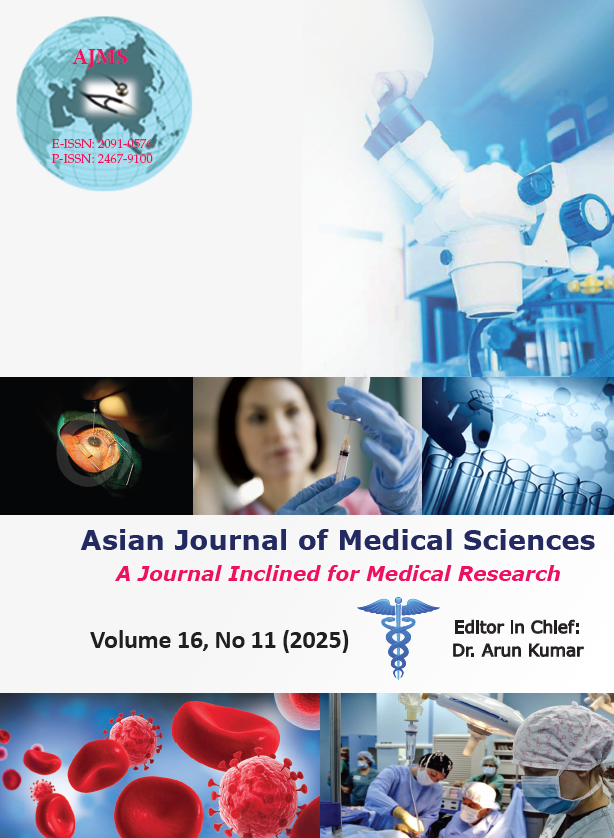Assessing local control, toxicity with hippocampal avoidance whole-brain radiotherapy with a simultaneous integrated boost for single and limited brain metastases
DOI:
https://doi.org/10.71152/ajms.v16i11.4861Keywords:
Brain metastases; Hippocampal avoidance; Simultaneous integrated boost; Stereotactic radiosurgery; Whole-brain radiotherapyAbstract
Background: Although whole-brain radiotherapy (WBRT) has been the standard treatment for brain metastases, its cognitive side effects have led to the rise of stereotactic radiosurgery (SRS), which offers better local control with less neurocognitive decline.
Aims and Objectives: This study aimed to determine toxicity using common terminology criteria for adverse events (CTCAE) grading and assess local control at the metastatic site and distant intracranial control using the response assessment in neuro-oncology (RANO) criteria for hippocampal avoidance WBRT (HA-WBRT) with a simultaneous integrated boost (SIB).
Materials and Methods: This cross-sectional study included 22 patients from Tirunelveli Medical College between February 2022 and June 2024. Data were collected through direct patient interviews, and baseline quality of life (QoL) was assessed using the European Organization for Research and Treatment of Cancer (EORTC) Quality of Life questionnaire (QLQ)-C15-PAL. Each patient underwent a planning computed tomography (CT) scan with thermoplastic mask immobilization. Gadolinium-enhanced T1-weighted magnetic resonance imaging (MRI) was co-registered with CT to delineate target volumes and organs at risk. The hippocampus was contoured per standard guidelines. The planning target volume for WBRT (PTV-WBRT) included the whole brain with a 3 mm margin, excluding the PTV-metastases and HA region. Toxicity (CTCAE) and QoL (EORTC) were evaluated at 3 months, and local tumor control was assessed at 6 months using RANO criteria and MRI assay.
Results: Local tumor control was achieved in 77.27% of cases. Local control was not significantly associated with age, gender, primary tumor site, or number of metastases, but was significantly lower in patients with associated extracranial metastases (P=0.0005). Patients with local control had significantly better QoL scores at baseline, 3-, and 6-month post-treatment (P<0.05). Radiologic tumor response assessed by RANO criteria at 6 months showed a strong correlation with local control (P=0.0005). Similarly, higher toxicity grades were significantly associated with a lack of local control at both 3 and 6 months (P=0.0002 and P=0.002, respectively).
Conclusion: HA-WBRT with a SIB achieved effective local tumor control and improved intracranial progression-free survival in patients with single and limited brain metastases. This approach showed minimal toxicity and was associated with significantly better QoL outcomes.
Downloads
Downloads
Published
How to Cite
Issue
Section
License
Copyright (c) 2025 Asian Journal of Medical Sciences

This work is licensed under a Creative Commons Attribution-NonCommercial-NoDerivatives 4.0 International License.
Authors who publish with this journal agree to the following terms:
- The journal holds copyright and publishes the work under a Creative Commons CC-BY-NC license that permits use, distribution and reprduction in any medium, provided the original work is properly cited and is not used for commercial purposes. The journal should be recognised as the original publisher of this work.
- Authors are able to enter into separate, additional contractual arrangements for the non-exclusive distribution of the journal's published version of the work (e.g., post it to an institutional repository or publish it in a book), with an acknowledgement of its initial publication in this journal.
- Authors are permitted and encouraged to post their work online (e.g., in institutional repositories or on their website) prior to and during the submission process, as it can lead to productive exchanges, as well as earlier and greater citation of published work (See The Effect of Open Access).





